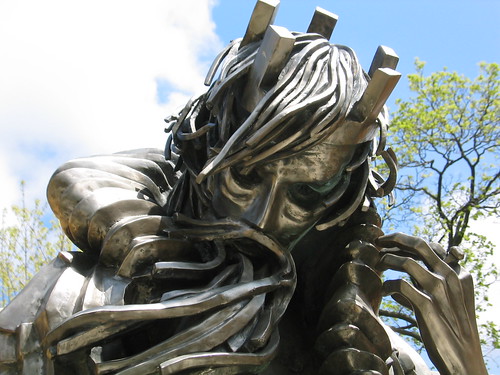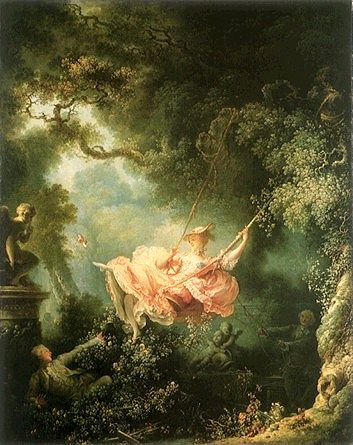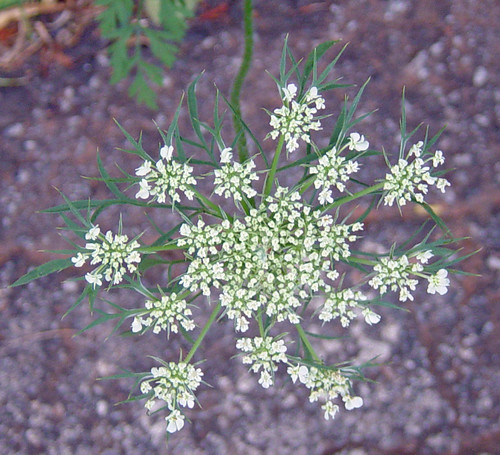You must read this!
1. William Carlos Williams & an informal explication of "The Great Figure"I didn't intend my question about "The Great Figure" to be a trick. But when we think about an author's purpose we think we are looking for something hidden *under* the words or *behind* the text. As if the text is there to cover up the true meaning. However, even in allegorical texts like
Grendel,
Lord of the Flies, and
Invisible Man the symbolic meanings are embeded *in* the text, in the word choices, in the descriptions, in the language.
So when in
Lord of the Flies William Golding writes about the first fire as a "squirrel" that develops into a "jaguar," we know that he is working on two levels: he describes the fire and he compares the fire to animals. Because he is working on the metaphorical (comparison) level as well as the literal level he invites a metaphorical/allegorical interpretation of the passage: "The fire is an animal that begins harmless (a squirrel) and becomes a predator (a jaguar); the boys themselves begin and end the same way.
Likewise when a writer wishes to draw our attention away from interpretation (away from looking behind or through an image for meaning, for example), we should find a text that foreground experience itself. So "The Great Figure" fixates on sensory experience and resists metaphorical/symbolic/allegorical readings. The poem encourages the reader to
experience and not to move away from the experience into metaphorical comparisons or symbolic meanings (though the reader, being a thinker and interpreter of all she sees may, of course, choose to associate the experience with larger themes of, say, the hectic nature of modern urban life). He sets the scene quite literally: "among the rain/and lights." We see rain. We see lights. Then we see (as the speaker does) the figure five. It's "gold/on a red/firetruck". Both the "gold" and the "red" come at the end of lines and are therefore emphasized. For a moment (as they eye ends one line and picks up another) the red--the pure color--dangles independently without its object. So we experience red before we even know what is red. The experience of seeing is foreground and the meaning of what is seen is in the background.
Then the static 5 (static at least
in the poem so far) is given motion. (Remember the reader's experience is ordered by the arrangement of words on the page not by what "really" "happened". So as we experience the "5" in the poem it is motionless until the word "moving". Then we realize (in the world) it has been moving all along though not in our mind's eye.)
The poem then becomes all movement & sound. The firetruck has "urgency", is "tense", and is "unheeded". ("Urgency" comes at the end of its line; the last two words stand alone for emphasis.) The firetruck moves "to" loud noises as a dancer moves to the music. (This reminds me of "Overture...") The movement & sound are synchronized in evoking an uneasy chaos in the reader.
The loud noises are "clangs" and "howls" and "rumbling". (Notice that like the colors and descriptions of the motion these sound words appear at the end of lines.) Clangs, howls, and rumbling are urgent and tense, like the firetruck's motion. If one is attentive to the words one will see the frenzied motion, hear the loud, insistent sounds, &
feel the tension and heedless urgency inside oneself.
The last line then provides stasis all of this noise and motion occurs against the static nothing of darkness. (This is a recontexualization--a new backdrop--for the image, movement, and sound. The speaker's first lines give us a different context: "rain"--vertical movement later contrasted by the horizontal movement--& "light"--later contrasted by the "dark city".)
The sensory experience created by the poem--the arrangement of particular words in a particular order with particular line breaks--recreates the experience seen & felt by the speaker. The poem must evoke that experience in order to be effective. That seems to be its purpose: to transform an experience of sight, sound, and feeling into words that will evoke those same sights, sounds, and feelings for a reader. The poem to succeed must create an experience *in* the reader.
Williams never tells us that what he sees is like anything else. No similes. No metaphors. No personification. No allegorical language.
He also tells no story. The are no characters. The fire is implied by absent. Completely absent. There is no rising action. No single climax (Instead the poem climaxes at the end of each line from line seven through thirteen: moving, urgency, tense, unheeded, clangs, howls, rumbling--before (perhaps) unifying all the action with the word "city".)* No resolution. Just sensory experience--a number, then color, then motion, then sound, then nothing--and the feelings evoked by sensory experience.
Why do this? Why is it significant to make literature in a way that is aggressively non-allegorical? Allegories can feel like meanings grafted onto things & experiences--separate and separable from things, from experiences. And so allegories can feel like lies. (Think of Grendel's reaction to the Shaper. Think of your own feelings about certain undefended, unexplained interpretations of literature.)
Are there other reasons to foreground sensory experience and resist allegorical interpretation? One might believe--as Williams seems to have--that in grasping for ideas and interpretations and implications and meanings we miss what is in front of us. Or to make the implication clearer we miss the
life that is in front of us. I think WCW makes the importance of attending to sensory particulars pretty clear in this poem:
so much depends
upon
a red wheel
barrow
glazed with rain
water
beside the white
chickens.
I read that first line as having at least two possible meanings. In the world beyond the poem that red wheel barrow might be crucial to the operation of the farm. Small but significant. In the world of the poem the entire poem depends upon the "red wheel / barrow" & its context. (Compare this to "The Great Figure". I think WCW's method is quite similar in the two poems.) Williams emphasizes particulars, things and experience. It is only *in* things that we can have ideas. (No ideas but in things.**) He seems to want to return us to a physical, sensory experience of our daily reality. Not a bad lesson in our increasingly "virtual" and "mediated" world.
A poem might be valuable because it helps us experience the world and word more vividly.
OK That's enough WCW for now. (We'll come back to his "Icarus" poem later.)
Notes:
*(If you doubt this reading notice line eight. Why doesn't Williams break the line at "weight" as we might expect based on the line lengths immediately before and after? Why? Because "weight" is a static word & the poem demands movement and sound from line seven through the penultimate line.)
**Notice that this edict can be applied to allegorical writing too. In truly effective allegory writers evoke the meanings that they feel are latent *in* things instead of grafting meanings onto things. (Think of William Golding's use of fire in
Lord of the Flies. He finds meaning in the properties of fire. He doesn't impose external meaning upon it.) When an artist paints a blue circle and then say that it symbolizes war that is probably a meaning imposed upon a thing rather than discovered within it or evoked by it.
2.Over vacation we will be reading As I Lay Dying by William Faulkner.
This novel will be the bridge between the poetry of self unit and the self & family unit.
Due 1/7.3. Next in the poetry unit we will be reading two dozen of William Shakespeare's 154 sonnets. The details are below:
Read the following sonnets at
http://www.shakespeares-sonnets.com/:
1, 3, 12, 14, 17,
18,
29, 30, 42 can be found
here.55, 73, 98, can be found here.
116, 126, 127, 129, 130, 133, 138, 143, 144, 147, 148, 152 can be found here.
There is helpful commentary on the site for each poem.
Read all 24.
Post six "SOAPSTone + Theme" responses to the blog. (Everyone must write about sonnet 130. In addition pick five other sonnets to respond to.) Due 1/4.
You will also need to memorize a sonnet for the midyear exam. More on that later.







